2022 How Does Remote Solar Power System Help Future Network Evolution?
- Richard Wang
- December 4, 2021
- 7:01 pm
Content:
1.The Contradiction Between Network Evolution and Power Supply
2.Problem of Existing Outdoor Remote Solar Power System Solution in the Market
3.Edgeware’s Solution-All in One Outdoor Remote Solar Power System
4.Edgeware Outdoor Outdoor Remote Solar Power System IP65 Solar Box
5.Outdoor Solar Remote Monitoring System for Edge Span Series Outdoor Remote Solar Power System
6.Summary
1.The Contradiction Between Network Evolution and Power Supply
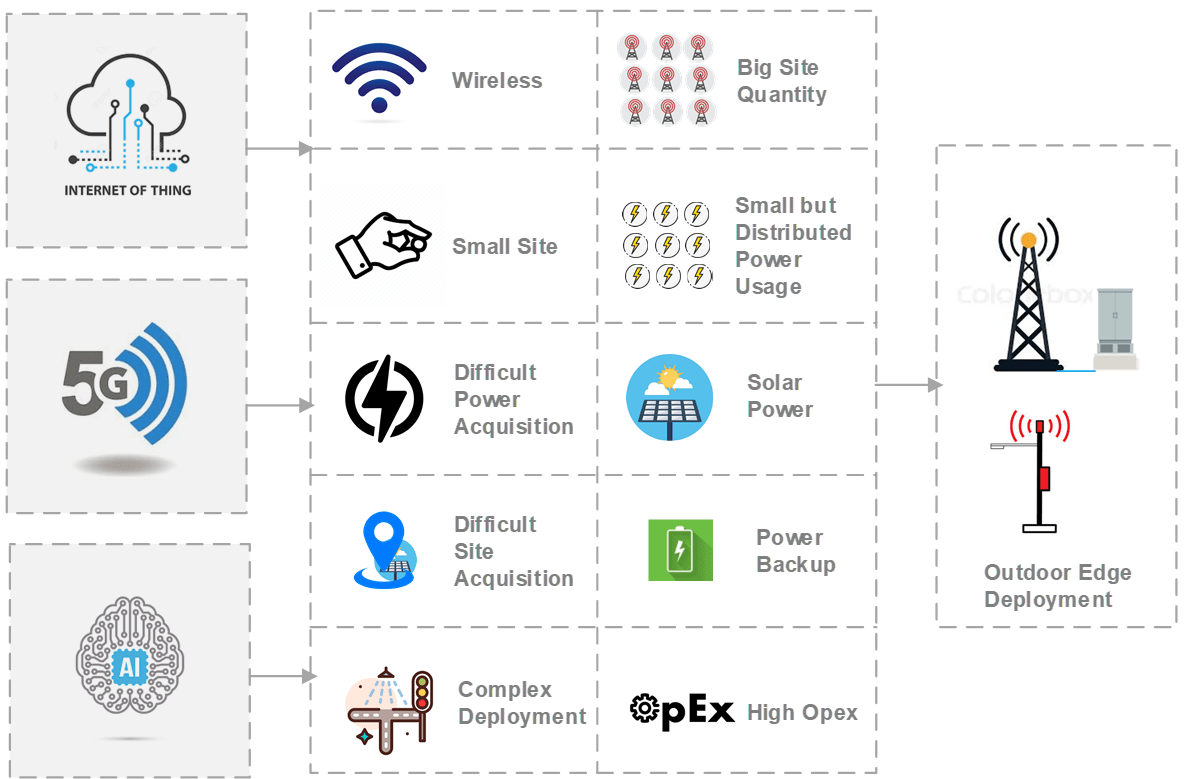
In recent years, various network technologies have evolved rapidly. The emergence of some major technologies such as IoT, 5G, and Starlink have brought great challenges to the deployment of edge networks. Traditional edge network deployment is usually based on outdoor cabinets, with power systems, network systems, control systems, etc. inside. However, with the emergence of new technologies, traditional edge network deployment methods must evolve to adapt to these trends.
Edgeware believes that whether it is IoT, 5G, or Starlink, the most significant trend that will bring to the edge network or the ToB edge is wireless backhaul. On traditional networks, we will aggregate services at the edge, and then transmit back through the aggregation network and the backbone network. In special cases, microwave network backhaul will be used. In this way, the aggregation of the entire network will be limited by the coverage of the optical fiber network and the cost of microwave coverage. At the same time, the energy density of a edge network site is relatively large. However, when services become wireless and 5G services based backhaul, especially after Starlink is widely online in the future, backhaul will not be limited to optical fibers. At this time, a single device or multiple devices can return data anytime and anywhere.
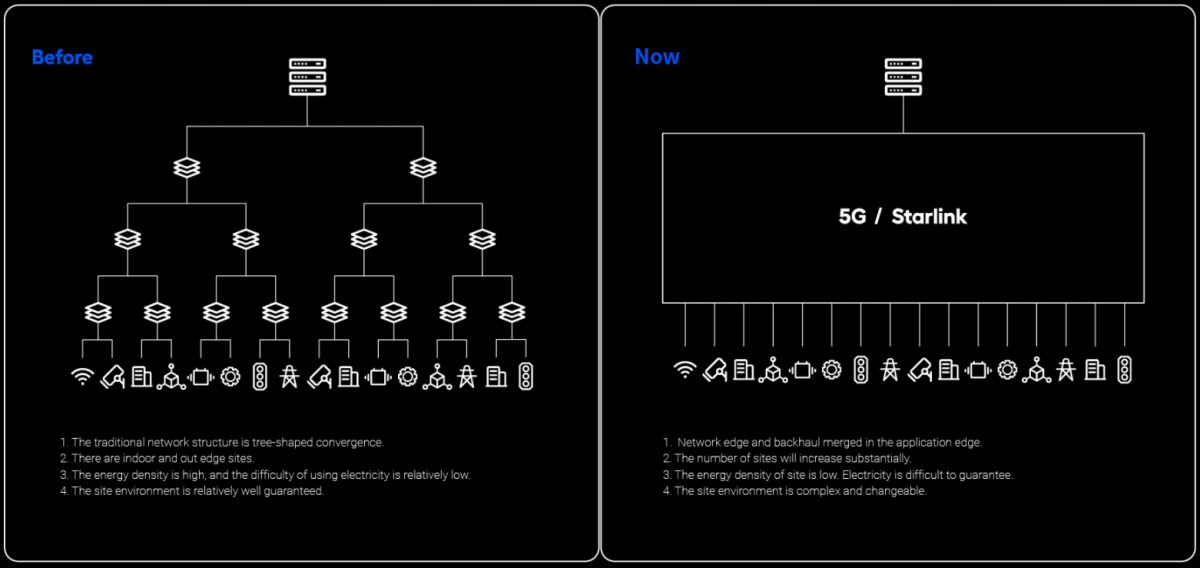
For IoT, gateway nodes have relatively low power consumption and low data traffic. However, the location of the site is usually in a place where it is difficult to deploy and obtain electricity. For example, Edgeware once deployed the Smart Agriculture project in the rural area of Colombia. These places are in farms in the rural area. It is not cost effective to obtain utility power for this low energy density and low data traffic site.
Therefore, we believe that future network evolution will generally bring about the following trends:
(1)Wireless backhaul
The wirelessization directly leads to the traffic not to aggregate level by level, but to direct wireless backhaul.
(2) The number of sites has increased dramatically
The wireless backhaul of sites, directly leads to a sharp increase in the number of sites. If it is not well monitored and managed. OPEX will increase dramatically.
(3) The site is miniaturized and the energy density is reduced
After the wireless backhaul of the site, the scale of the site will become smaller, resulting in a decrease in the energy density of a single site. If these small sites are connected to the utility power, the cost of OPEX will become very high. The corresponding OPEX cost per bit/s will increase sharply.
(4) Distributed, scattered and random access to electricity
After the site is miniaturized, the location of the deployment site is random and scattered, which brings about a distributed power architecture.
These trends will bring several problems to our edge network deployment and OAM:
(1) Difficult to get electricity
The evolution of the world’s network and the evolution of electricity are very out of sync. Electricity is still under the technology of the last century, and we cannot expect to get electricity anytime and anywhere. This simply cannot match the trend of network evolution, miniaturization, wireless, and distributed deployment.
(2)Power backup
In many countries and regions, the power network is very unstable. You can’t expect the power network to run 100% reliably, so you have to configure power back and battery
(3) The deployment environment of the site is complex
After going wireless, you can’t always expect the site to land on the street, central office and other easy-to-deploy places. It often appears on the roof, street light pole, rural field, farmland and so on. This makes the deployment environment complicated. It is not only the application itself that needs to be considered, but also the impact of the environment on the system, the difficulty of obtaining the site, and so on.
(4) OPEX increase a lot
Under this trend, the number of sites has increased, and the difficulty of management has increased. If the overall monitoring and operation and maintenance are not done well, it is conceivable that OPEX will increase sharply.
The overall reason for these contradictions is that the evolution of the power network is much slower than the evolution of the network.
2.Problem of Existing Outdoor Remote Solar Power System Solution in the Market
The challenges posed above can be solved by outdoor remote solar power system. I think this is a common voice in the market. However, what I want to say is, are we doing well enough? The following is a real scenario:
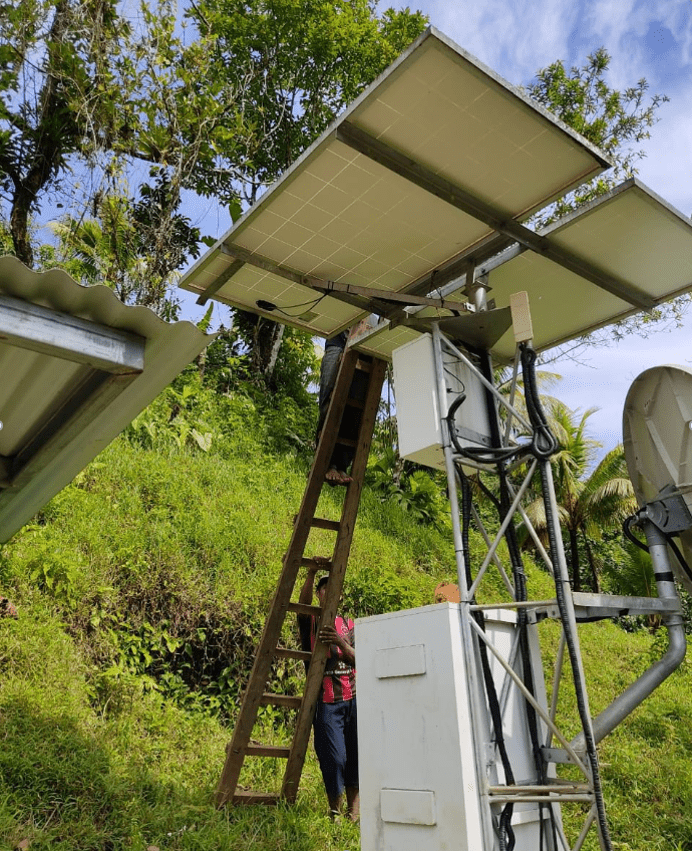
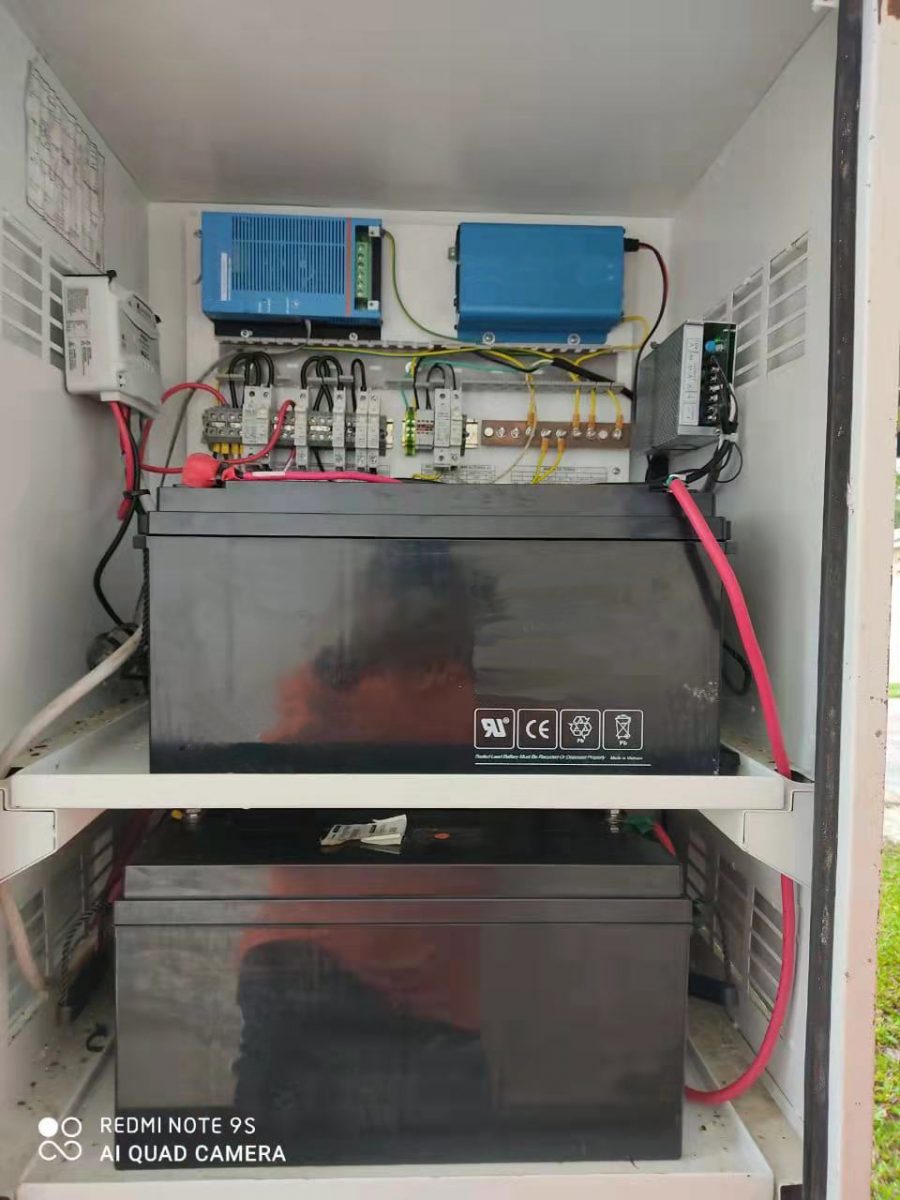
What we can see in this case is a typical outdoor remote solar power kits in the market. This is a typical way of thinking, but it does not conform to the evolution trend we just mentioned. When this type of deployment appears in a large number of small sites, it is conceivable that it is impossible to deploy on a large scale.

This is a solution that can be found on the market. Of course it also has some other variants. But let’s think about it, is this really good enough? I think at least a few aspects are not in line with future evolution trends:
(1)Big Big Too Big
It is true that you have implemented the function, but just like what we explained before, the size of edge network site will be miniaturized in the future, and the number of sites will increase sharply. Are you sure you want to deploy such big fat solar solution everywhere? The environment of the future site will also be quite complicated. It can be seen that the site is in the rural area. We can imagine how expensive to deploy this kind of big solar system.
(2) Are you deploying your application or these big guys in the end?
Like we said, your site will be miniaturized in the future, with low energy density. But in the end you will find that whether it is CAPEX or OPEX, a large amount of investment is spent on these big guys.
Of course, there are many little guys on the market, but don’t forget that many of them are designed for home networks, and your deployment is carrier level. Are you sure it is appropriate to use them?
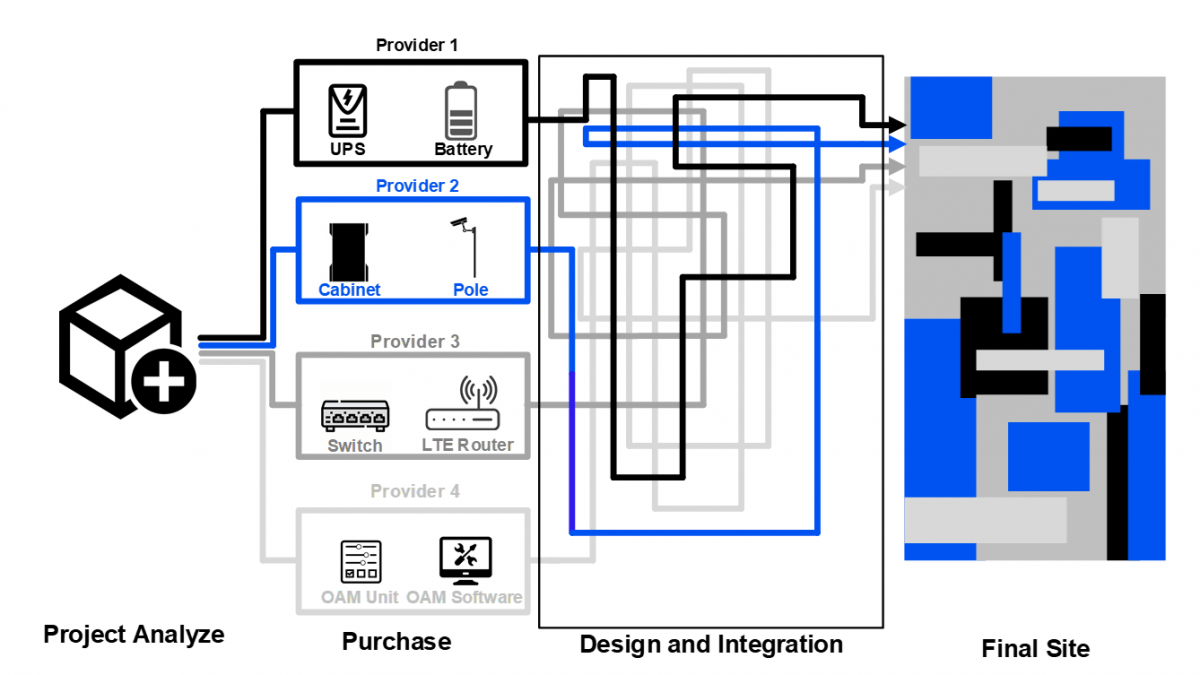
The problem that arises is that the supplier will not consider the design of your scene and project. They all only consider how to design products from their own product dimensions. So the solar product manufacturer is responsible for the solar, and the cabinets responsible for the cabinets, switching routers and other network equipment manufacturers have their own considerations. Finally, you are responsible for the integration of Outdoor Deployment monitoring. Therefore, in the solar solution, the supplier only considers the realization and standardization of the product, and does not consider your final use and scenario, let alone the future evolution trend. And this kind of project mode, you have to integrate it yourself in the end, and its structure is like walking a maze, and you can get it through at the end, then congratulations. If you don’t get through, it seems that no one will stand up and be responsible for you.
3.Edgeware's Solution-All in One Outdoor Remote Solar Power System
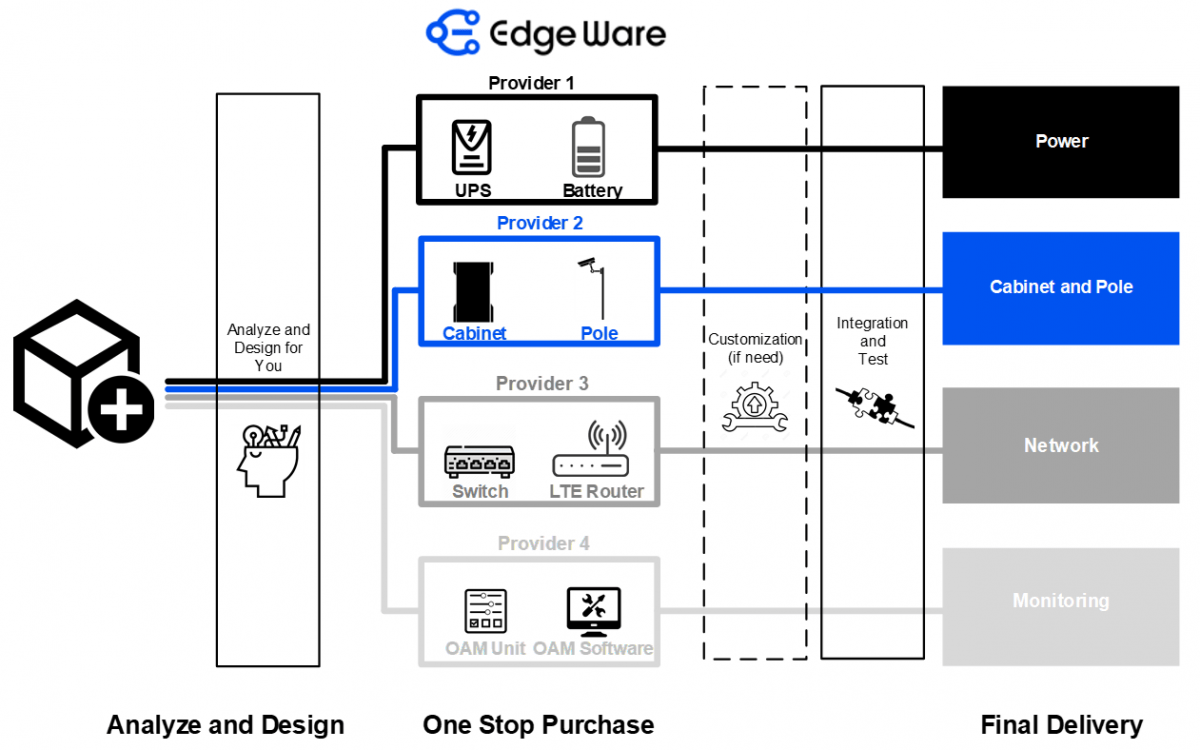
Edgeware believes that in order to respond to the trend of network evolution, different functional components must be integrated into an All in One system, and customized based on scenarios:
(1)All in One
Edgeware can participate in the design of the project with you based on its own knowledge of network, energy, monitoring and maintenance and business. And design all the functions required by your scene into an All in One system.
(2) Customization based on scenarios
Edgeware believes that the application form of the edge network is changeable and the environment is complex, and we need to customize case by case for the customer’s scenario. Instead of having suppliers develop standard products, customers adapt to our existing products
(3) Miniaturization
Because of the design of All in One and customized design, we can miniaturize and lighten the whole system, which is suitable for deployment on edge networks.
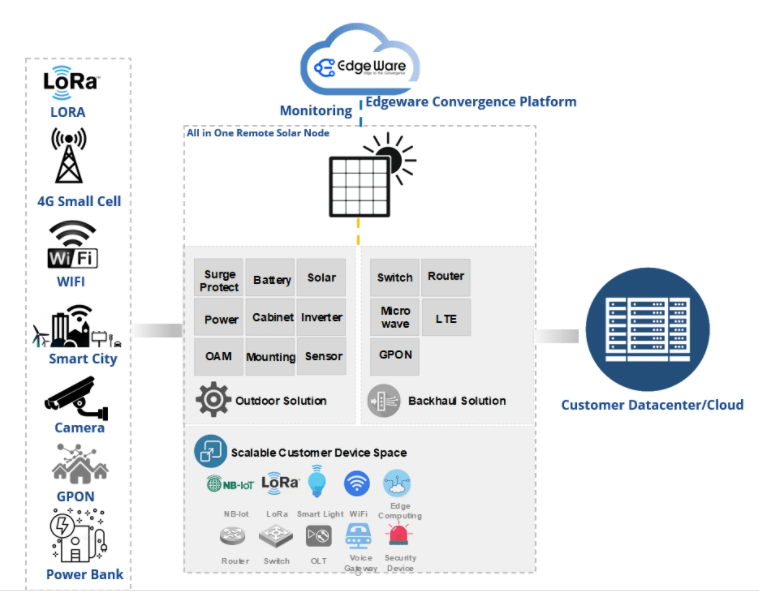
This is a simplified model. We believe that the outdoor remote solar system should be an All in One unit. It is pre-integrated before leaving the factory by Edgeware. The main body is divided into four parts:
(1)Solar Power
(2)Network
(3)Application
(4)Monitoring
Based on this, the Edge Network node is evolved into a fusion node. The advantages are as follows:
(1) Pre-integration, rapid deployment on site
Edgeware manufactures All in One devices according to your needs. You do not need to connect power, network, and business equipment to the site. Greatly reduce the installation cost of the station.
(2) Plug and Play, easy operation
No complicated connections, no troubleshooting, plug and play. And because of its miniaturization and lightness, no matter what the installation environment, the installation cost is extremely low.
(3) Whole system monitoring
We think OPEX for outdoor deployment of Edge network is a part that needs special attention. When we provide you with a monitoring and management software platform for the whole system, when there are a huge number of small sites, because of the existence of the monitoring and management software platform, your OPEX will be greatly reduced.
(4) Customization based on modularization
Because of the large amount of customization work, Edgeware has accumulated a large number of basic functional units. These modular units can complete your final plan like playing LEGO. This is customization based on modularity.
(5) High reliability
Because of the All in One design of the system and the overall consideration, the reliability is much higher than the patchwork cabinet solution.
4. Edgeware Outdoor Outdoor Remote Solar Power System IP65 Solar Box
Aiming at the three major design concepts of Edgeware, All in One, it is customized and miniaturized based on the scenario. We have launched an outdoor remote solar box with an IP65 level suitable for rapid deployment. We named it the Edge Span S series, and hope that with its help, it will help you to cross the last mile of the network and easily deploy the edge network. Edge Span is made of cast aluminum as a whole, with high protection capability, suitable for deployment in various harsh environments. Edge Span is designed with the goal of maintenance free as a whole to minimize your maintenance costs. It is a perfect small solar backup system or we can call it small-scale off-grid solar system.
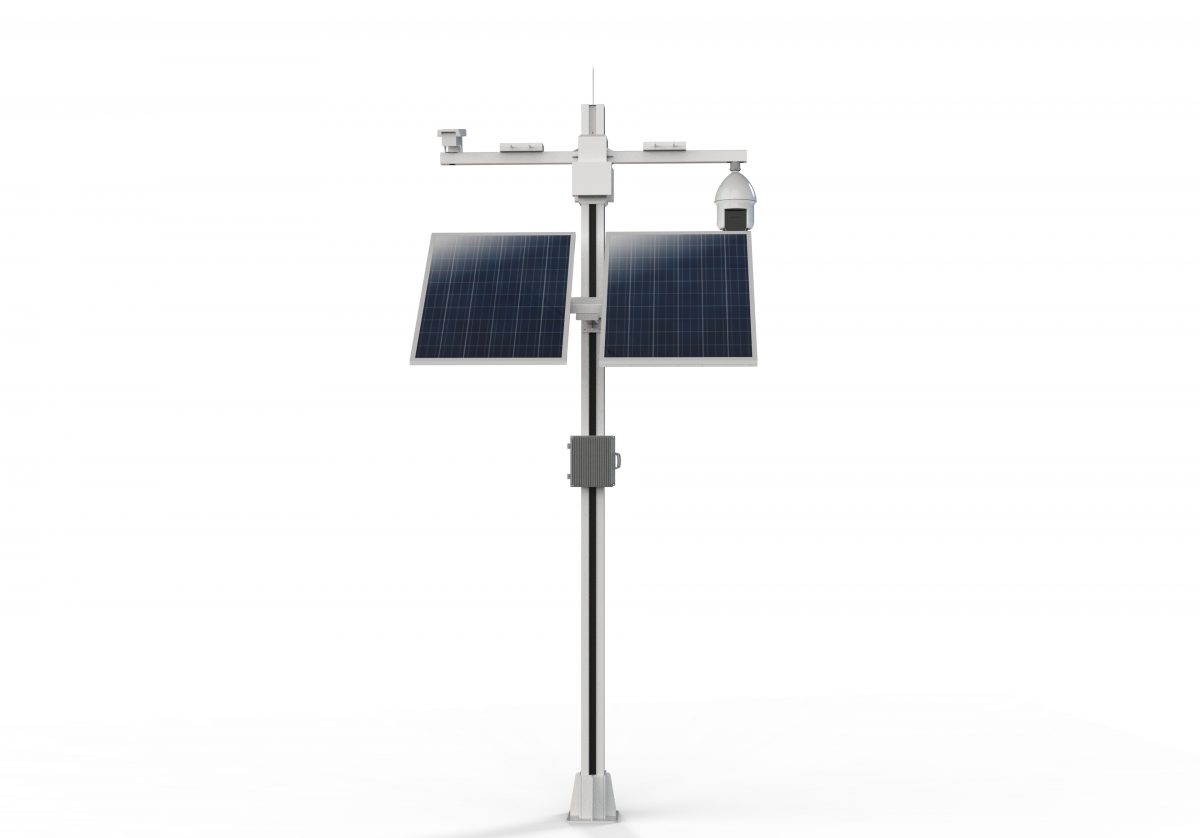

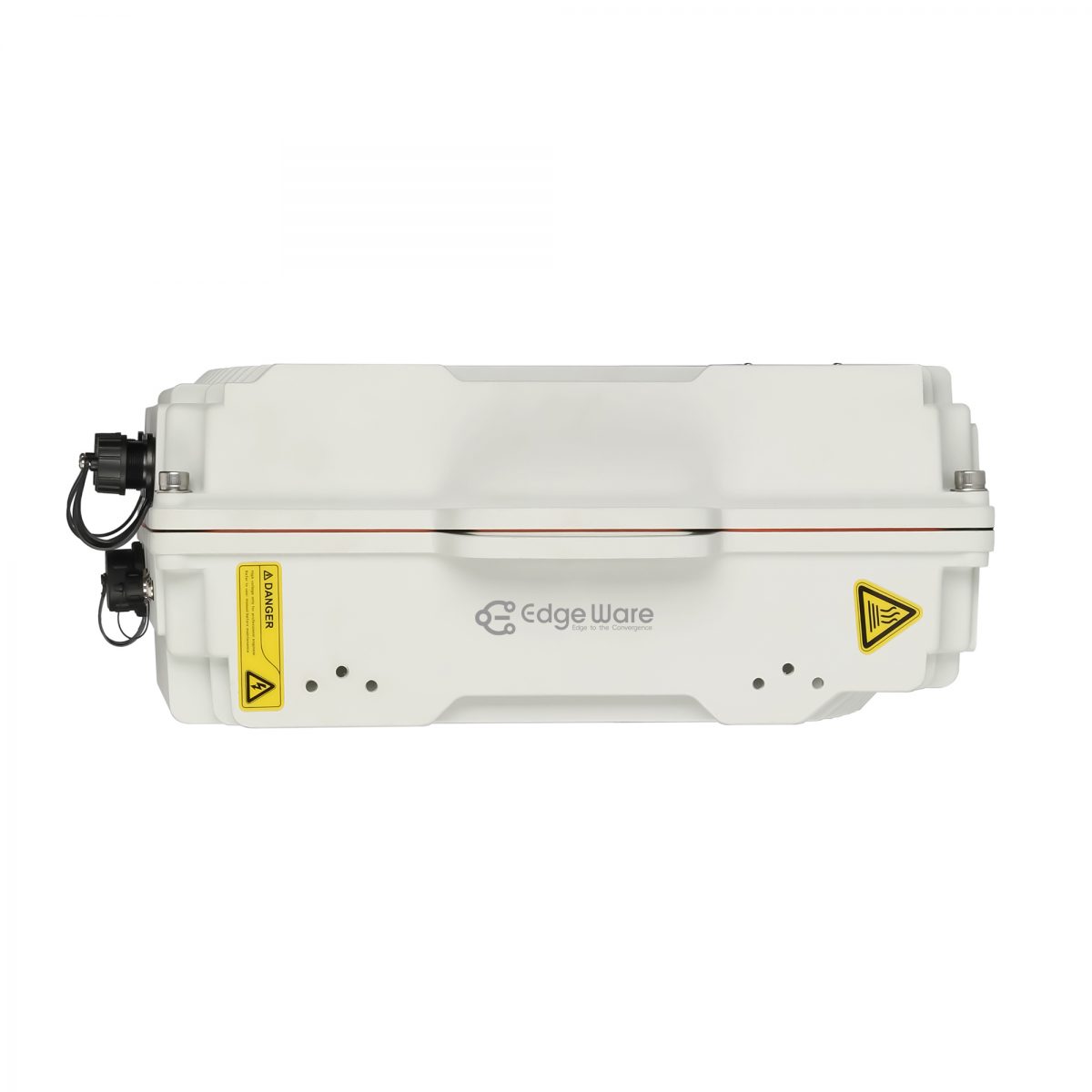
(1) All in One
Edge Span contains 500W 48V MPPT solar controller, lightning protection unit, battery unit, and monitoring unit. All functions are integrated into a box and highly integrated. It can be a perfect integrated stand alone solar power system deployed in rural area. In terms of network modules, there are LTE modules with POE, switching modules with POE, and edge computing modules. At the same time, we can also customize the network modules that customers need. In terms of battery, we provide different specifications of lithium batteries, customized according to customer requirement. The battery comes with BMS, which can be reported to Edgeware’s Convergence Software Platform in cooperation with the monitoring unit in Edge Span. In terms of monitoring, operation and maintenance, we have carried out detailed monitoring and control of the entire system, which we believe will play a vital role in reducing OPEX.
(2) Customization based on scenarios
Edge Span is not a standard product, we customize the model case by case according to customer needs. We can achieve many changes.
(3) Miniaturization
The overall weight of Edge Span varies from 8kg to 13kg according to different configurations, which is small and lightweight. A single engineer can realize the installation. No need to use heavy tools such as cranes. In Latin America, there was a record of installation and deployment completed in the fastest 15 minutes.
Let’s go back and take a look at the challenges brought about by the future network evolution trends mentioned at the beginning of the article:
(1) Difficult to get electricity
The Edge Span S series is designed based on solar energy, so in most scenarios, solar energy is a reliable source of energy you can rely on. Your network will no longer be limited to the provision of electricity.
(2) Power Backup
There is no longer a problem of power backup, because the battery is sufficient to support the operation of the system when the solar station is properly designed.
(3) The deployment environment of the site is complex
Edge Span is miniaturized and lightweight. Can be easily installed in various environments. And because the Edge Span integral aluminum shell is cast, IP65 protection. The surrounding complex environment, whether it is high humidity, high salinity, desert, etc., will not affect the overall stability of the system.
(4) OPEX increase a lot
Edge Span is maintenance-free as a whole and has a one-piece design. And the powerful monitoring function makes you know the whole system running status.
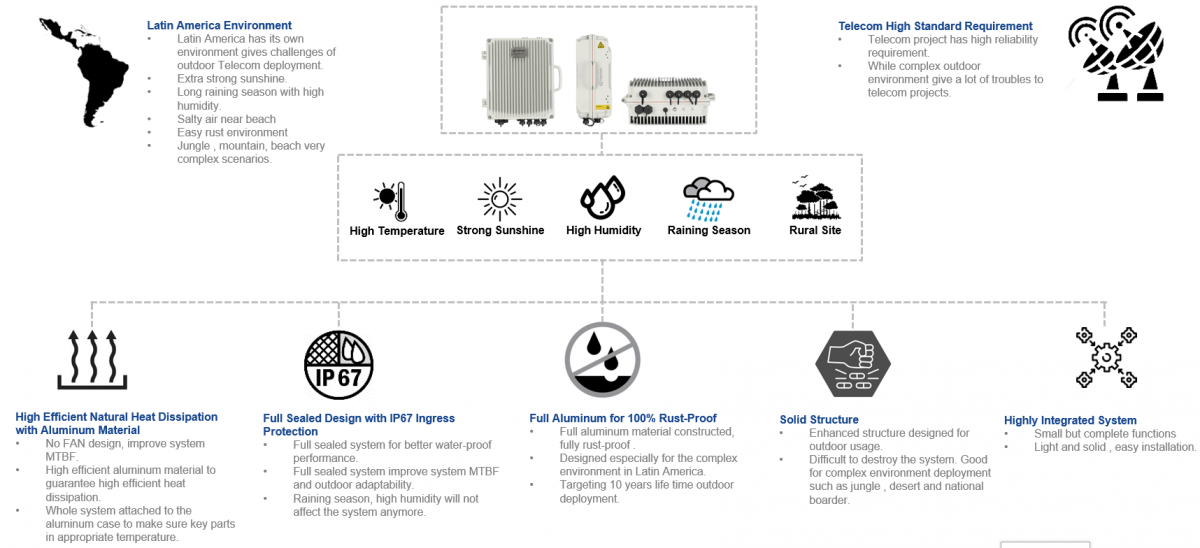
If you need to know more details, you can refer to the product introduction of Edgeware Edge Span Solar series webpage:
Outdoor UPS System with POE and Battery-Edgeware Edge Span U60-LSP
5. Outdoor Solar Remote Monitoring System for Edge Span Series Outdoor Remote Solar Power System
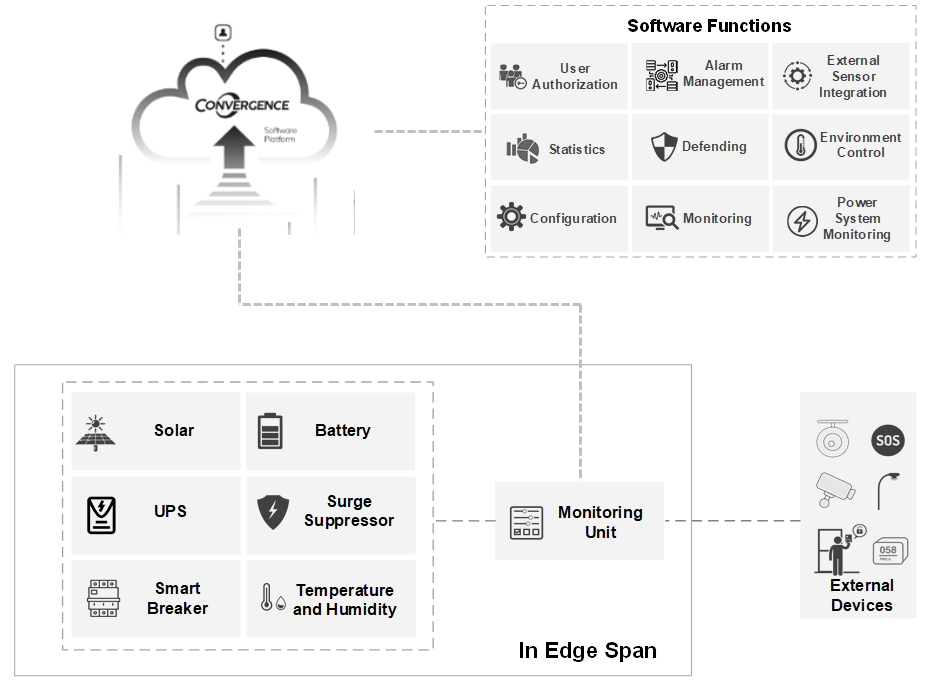
Edge Span series built-in monitoring unit can provide outdoor solar remote monitoring function. The whole system, such as solar controller, battery, temperature and humidity, etc., are all under the monitoring of the software platform. It is a perfect outdoor remote monitoring system for solar power plant. In this way, we can know the working status of the remote solar site in the central office. If there is an abnormality or alarm, we know how to deal with it, whether it is necessary to replace spare parts, and solve the problem at one time. Imagine if there is no remote monitoring, you only know that there is a problem with the site when you receive a complaint. Then go to the station to check the problem, return to the central office to prepare to replace the spare parts, and then go to the station again to fix the problem. This involved engineers arriving at the site multiple times, directly affecting OPEX.
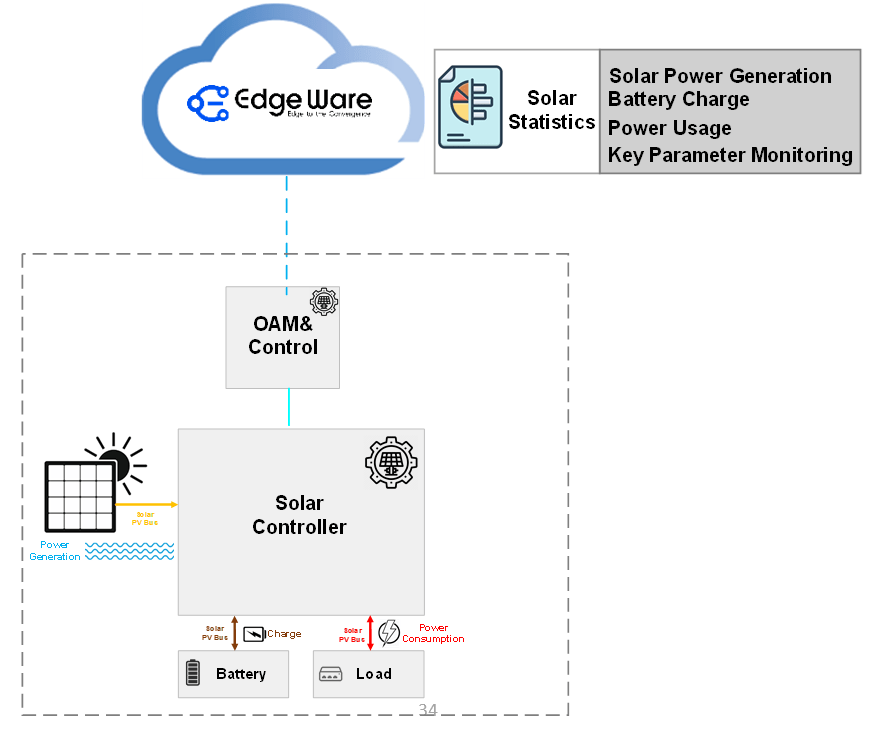
Edge Span can perform detailed statistics on solar energy generation, charging capacity and load usage. In this way, users can plan future expansion, equipment installation and other issues based on statistics.
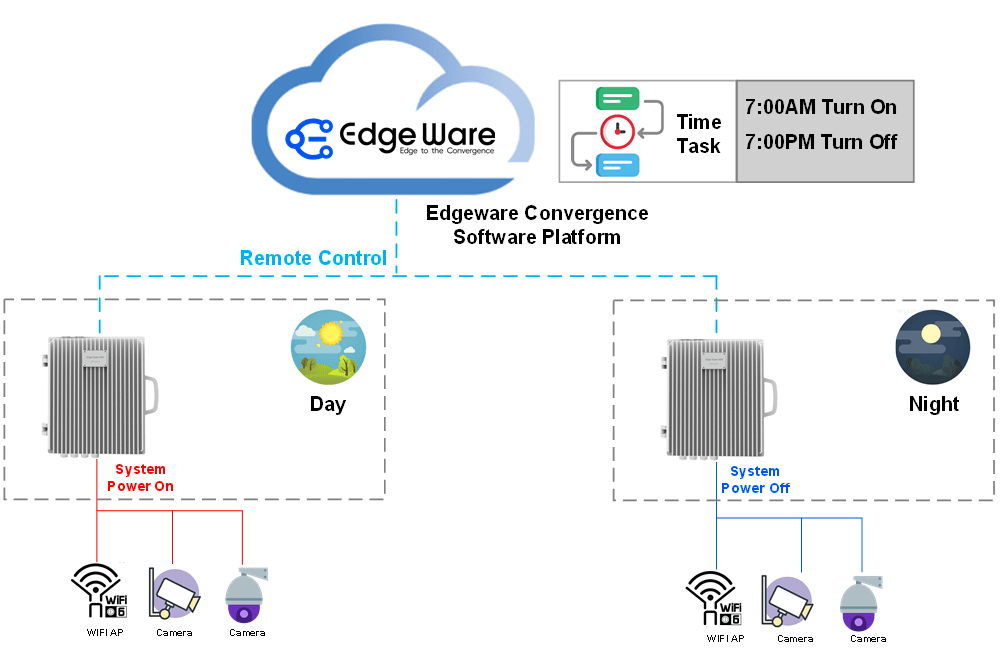
Edge Span also has a remote control function. We have found that many users use their devices only at certain times of the day. However, when we design a solar system, if we assume that the system is turned on for 24 hours to design the battery capacity, it will exceed the actual demand and increase unnecessary CAPEX. Therefore, we designed the function of opening and closing the system according to the time setting on the software platform
If you need more information about Solar Remote Monitoring System, you can refer to the following link or contact our sales staff:
Edgeware Outdoor Power Management Platform – Convergence Software Platform
6. Summary
We believe that the future world needs such miniaturized, All in One equipment. It can be widely used in various fields such as video surveillance, satellite network access in remote areas, smart cities, and safe cities. I hope Edgeware can work with you to make the deployment of the last mile of the edge network no longer difficult.
Reference
Hoffman, Chris (January 7, 2019).
“What is 5G, and how fast will it be?”
Wiki Satellite Internet Access
https://en.wikipedia.org/wiki/Satellite_Internet_access
Alex Fabiannede Paulo Geciane Silveira Porto
Evolution of collaborative networks of solar energy applied technologies
https://www.sciencedirect.com/science/article/abs/pii/S0959652618327057
Solar Energy Evolution and Diffusion Studies -NREL
https://www.nrel.gov/solar/market-research-analysis/seeds.html
More Topics:
1.74KW Outdoor Telecom Cabinet Rectifier System EPU43K4-B3A21
1.74KW Outdoor Telecom Cabinet Rectifier System EPU43K4-B3A21 1.74KW EPU43K4-B3A21 Outdoor Telecom Cabinet Rectifer Overview EPU43K4-B3A21 rectifier system is designed to work in outdoor telecom cabinet
Power Supply Enclosure, Outdoor Ups for Video Surveillance, Edge Span U200-LSP All in One UPS
Edge Span U200 Outdoor UPS is an All in One power supply enclosure designed by Edgeware specifically for outdoor edge network applications. Especially suitable as Outdoor ups for video surveillance. You can learn about the overall functions from this video, and you can also find detailed information in the Edge Span U200 product, as follows:
https://edgewaretech.com/9540.html
The Original Intention of Edgeware, Edge to The Convergence
The Original Intention of Edgeware, Edge to The Convergence The ICT world is changing rapidly, the network evolves too fast, and then the Edge Network
Solar panel Off-grid Video Surveillance PowerCube for 2-8ch Solar Powered 4G Security Cameras
Solar panel Off-grid Video Surveillance PowerCube for 2-8ch Solar Powered 4G Security Cameras Share on facebook Share on twitter Share on linkedin Share on whatsapp
Power on PWU of Edge Span Tiny-Perfect Surveillance Cameras Power Supply with UPS and Battery
Power on PWU of Edge Span Tiny-Perfect Surveillance Cameras Power Supply with UPS and Battery Share on facebook Share on twitter Share on linkedin Share
Edge Span B200 Outdoor Battery Enclosure Best Battery for Solar Power Storage With IP65 Ingress Protection
Edge Span B200 Outdoor Battery Enclosure Best Battery for Solar Power Storage With IP65 Ingress Protection Share on facebook Share on twitter Share on linkedin

